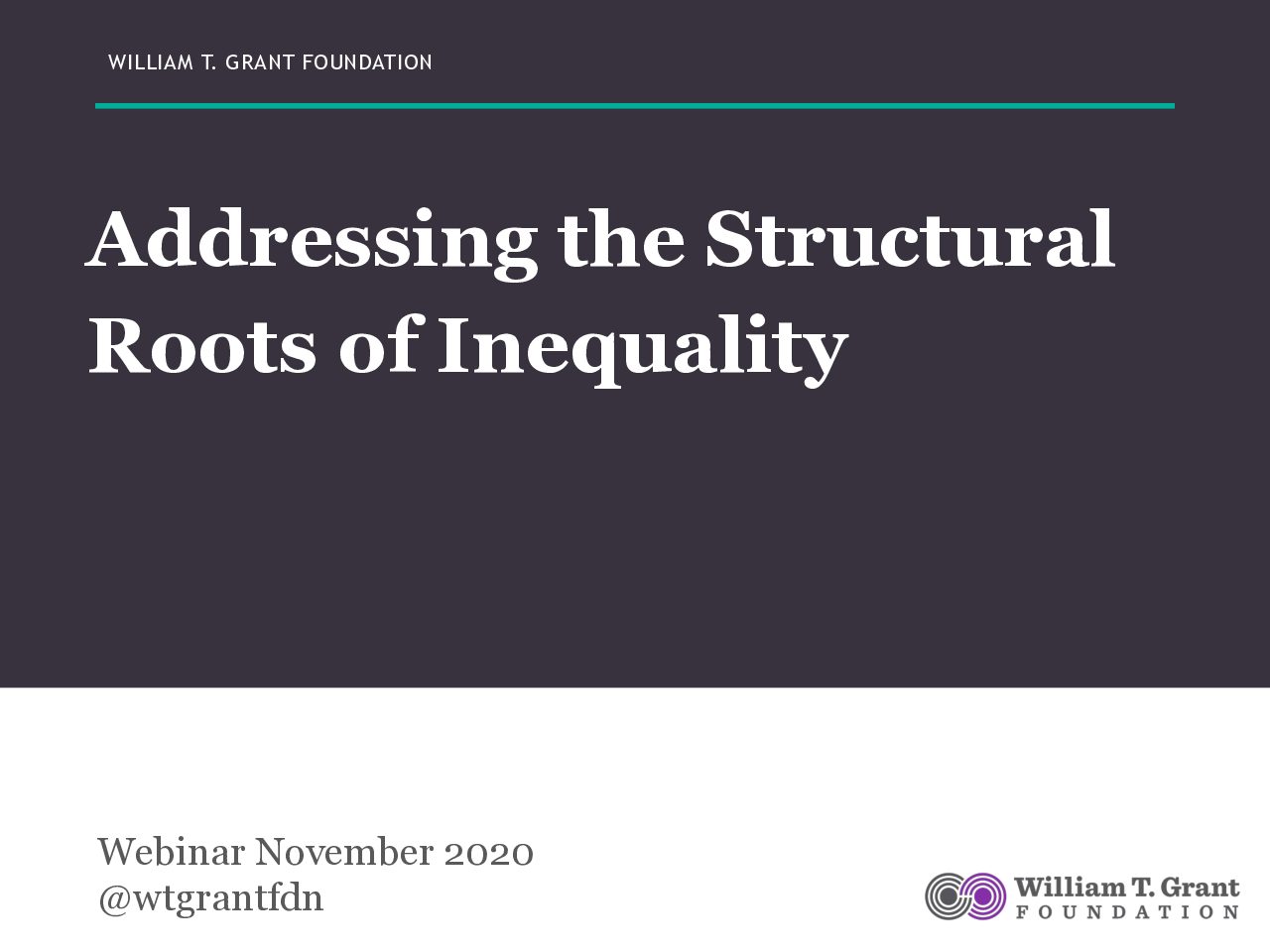Since 2015, the William T. Grant Foundation has funded exciting and important research that examines programs, polices, and practices to reduce inequality among youth ages 5-25 in the United States. If you are considering applying for a major grant or Officers’ research award in our reducing inequality focus area, we encourage you to closely evaluate whether your proposed study is a fit with our funding interests. Studies that do not fit with our interests generally do not move forward in our review process; between 20-30% of the letters of inquiry we receive are not a fit with our funding interest in reducing inequality.
The tips below are meant to help you evaluate whether your research might be a good fit. They are not in any rank order—each tip is important to consider as you prepare your application.
01.
Is your study focused on reducing inequality? A strong letter of inquiry is clear about how the proposed research will yield robust findings on a program, policy, or practice to diminish, disrupt, or end youth inequalities. We welcome descriptive studies that clarify mechanisms for reducing inequality or explain how or why a program, policy, or practice reduces inequality. We also welcome intervention studies that examine attempts to reduce inequality and studies to improve the measurement of inequality in ways that can enhance the work of researchers, practitioners, or policymakers. Letters of inquiry that propose research that will primarily describe inequality and its consequences do not advance in our review process. Relatedly, it is not enough to promise that a study will examine what inequality looks like to reveal ways to reduce it. The examination of a response to inequality should be central to the proposed study.
02.
Will your study examine, build, or inform understanding of a program, policy, or practice that can be implemented through a youth-serving system? One way to judge whether your study is a fit with our interests is to ask whether it is clear how the research will develop, inform, or examine a strategy that could be enacted in real-world contexts, such as schools, child welfare agencies, prosecutor offices, or other youth-serving entities. Applications that can demonstrate a pathway to implementation are encouraged.
03.
Does your letter of inquiry specify the dimension(s) of inequality to be addressed? The Foundation prioritizes research that examines ways to reduce unequal outcomes along the dimensions of race, ethnicity, economic standing, immigrant origin, and/or language minority status. We are also interested in studies that address inequalities experienced by LGBTQ youth. If it is not clear in the letter of inquiry that you are focusing on one or more of these dimensions, your study is probably not a fit with our interests.
04.
Does your letter of inquiry specify the youth outcomes on which your study will focus? The Foundation is especially interested in supporting research to reduce inequality in academic, social, behavioral, or economic outcomes. The letter of inquiry should specify how outcomes are unequal by race, ethnicity, economic standing, immigrant origin, and/or language minority status. It should also specify the outcomes the study will examine and how they will be operationalized. If the study will not directly assess whether a program, policy, or practice improves youth outcomes, the letter of inquiry should offer a convincing theoretical and empirical rationale for why the proposed strategy is expected to improve youth outcomes in the long-term.
05.
Does your letter of inquiry richly conceptualize inequality? This is about more than naming the dimension of inequality to be addressed and showing how outcomes are unequal. The strongest letters of inquiry we receive draw on empirical and theoretical literature to present a well-developed discussion of what inequality looks like for a particular population(s) of youth and why it exists (e.g., what outcomes are unequal and why are they unequal?). Developing a rich, but concise, conceptualization of inequality is important for explaining why a program, policy, or practice is expected to effectively reduce inequality.
06.
Does your letter of inquiry explain why a program, policy, or practice is expected to reduce inequality? Strong letters of inquiry clearly describe the connection between the existing inequality, the reasons for that inequality, and why the program, policy or practice under study will reduce that inequality. For example, if you highlight the implicit racial bias of teachers as a primary reason Black youth are more likely to be suspended from school than White students, reviewers will want to see how a program, policy, or practice might change teacher racial bias in a way that is expected to reduce the racial gap in suspension rates.
07.
How will your study provide evidence on whether a program, policy, or practice reduces inequality? Some applicants examine how disparities between groups are reduced (e.g., academic outcomes between Black youth and White youth), while others examine how outcomes are improved for a particular population of youth (e.g., how economic outcomes are improved for youth from low-income families). The letter of inquiry should be clear about how the proposed research design will answer the question of whether and/or how inequalities between groups are reduced or outcomes are improved for youth populations that need it the most.
08.
Speaking of research design, is your study’s design well-aligned with your research questions? The Foundation supports research that uses quantitative, qualitative, and mixed methods approaches. What matters to us is that the methods are rigorous and aligned with the questions asked. Some examples of recently funded studies include: a cluster randomized waitlist-controlled trial study of an intervention to reduce suicidal behavior among Latinx and LGBTQ youth; a mixed methods study of whether and how a place-based initiative improves academic outcomes for Black youth; and a design-based implementation research study to build an adaptive, culturally responsive professional development program to improve math instruction for Latinx students.
09.
A final note: while the Foundation has recently encouraged applicants to focus on responses to the macro-structural foundations of inequality, your study does not need to align with this interest to be a good fit. We continue to support studies of programs, policies, and practices to reduce inequality.
To assess how well your proposed study fits with our interests, try the simple test of completing the italicized sections of this sentence:
This study examines whether/how [a program, policy, or practice] reduces inequalities in [specific youth outcome] for [dimension of inequality] youth.
For example:
This study tests whether a prosecutorial intervention reduces inequalities in incarceration rates for Black, Latinx, and Indigenous youth compared to White youth.
This project explores the mechanisms by which civic engagement reduces inequalities in mental health outcomes for LGBTQ youth.
This project examines whether district-level school desegregation policies reduce inequalities in academic outcomes for Black and Latinx youth from low-income families.
Consider the examples above that complete the “fit” sentence. They each indicate which youth are the focus of the study. Thus, one test you can use to evaluate whether your study is a fit with our interests is to ask whether your “fit” sentence indicates a specific group(s) for whom outcomes are currently unequal. While this is not a requirement, it is a way to gauge whether your proposed research centers a clear dimension of inequality. Note as well that the verb in the test sentence changes in each example to align with the proposed methods. Finally, each sentence represents a study focused on reducing inequality; a study focused on describing inequality might read, for example, “This study examines how prosecutorial decision-making reinforces and exacerbates inequality.”





